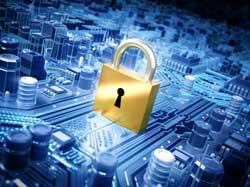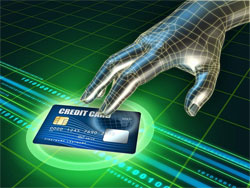A Networked World: New IT Security Challenges
 This is the age of networks. Long ago, they said, ‘the mainframe is the computer’. Then it changed to ‘the PC is the computer’. That was followed by ‘the network is the computer’. Our world has been shrunk, enlightened and speeded up by this globe encapsulating mesh of interconnectivity. Isolation is a thing of the past. Now my phone brings up my entire music collection residing on my home computer. My car navigates around the city, avoiding traffic in real time. We have started living in intelligent homes where we can control objects within it remotely.
This is the age of networks. Long ago, they said, ‘the mainframe is the computer’. Then it changed to ‘the PC is the computer’. That was followed by ‘the network is the computer’. Our world has been shrunk, enlightened and speeded up by this globe encapsulating mesh of interconnectivity. Isolation is a thing of the past. Now my phone brings up my entire music collection residing on my home computer. My car navigates around the city, avoiding traffic in real time. We have started living in intelligent homes where we can control objects within it remotely.
On a larger scale, our road traffic system, security CCTV, air traffic control, power stations, nuclear power plants, financial institutions and even certain military assets are administered using networks. We are all part of this great cyber space. But how safe are we? What is our current level of vulnerability?
Tower, Am I Cleared For Landing?
March 10, 1997: It was a routine day of activity at Air Traffic Control (ATC) at Worcester, Massachusetts, with flight activity at its peak. Suddenly the ground to air communications system went down. This meant that ATC could not communicate with approaching aircraft trying to land. This was a serious threat to all aircraft and passengers using that airport. All incoming flights had to be diverted to another airport to avoid a disaster.
This mayhem was caused by a 17 year old hacker named Jester. He had used a normal telephone line and physically tapped into it, giving him complete control of the airport’s entire communications system. His intrusion was via a telephone junction box, which in turn ended up being part of a high end fire backbone. He was caught when, directed by the United States Security Service, the telephone company traced the data streams back to the hacker’s parents’ house. Jester was the first juvenile to be charged under the Computer Crimes Law.
As our world becomes more and more computerised and our computer systems start interconnecting, the level of vulnerability goes up. But should this mean an end to all advancement in our lives? No. We need to make sure we are safe and the things that make our lives easier and safer are also secure.
Intruder Alert
April 1994: An US Airforce Base realised that their high level security network was not just hacked, but  secure documents were stolen. This resulted in an internal cyber man-hunt. The bait was laid and all further intrusions were monitored. A team of 50 Federal Agents finally tracked down 2 hackers who were using US based social networking systems to hack into the Airforce Base. But it was later revealed that the scope of intrusion was not just limited to the base itself: they had infiltrated a much bigger military organisation. The perpetrators were hackers with the aliases of ‘datastreamcowboy’ and ‘kuji’.
secure documents were stolen. This resulted in an internal cyber man-hunt. The bait was laid and all further intrusions were monitored. A team of 50 Federal Agents finally tracked down 2 hackers who were using US based social networking systems to hack into the Airforce Base. But it was later revealed that the scope of intrusion was not just limited to the base itself: they had infiltrated a much bigger military organisation. The perpetrators were hackers with the aliases of ‘datastreamcowboy’ and ‘kuji’.
‘Datastreamcowboy’ was a 16 year old British national who was apprehended on May 4th 1994, and ‘kuji’ was a 21 year old technician named Mathew Bevan from Cardiff, Wales. ‘datastreamcowboy’ was like an apprentice to ‘kuji’. ‘datastreamcowboy’ would try a method of intrusion and, if he failed, he would go back to ‘kuji’ for guidance. ‘kuji’ would mentor him to a point that on subsequent attempts ‘datastreamcowboy’ would succeed.
What was their motive? Bragging rights in the world of hacking for being able to penetrate the security of the holy grail of all hackers: the Pentagon.
But the future might not see such benign motives at play. As command and control of military installations is becoming computerised and networked, it has become imperative to safeguard against intruders who might break into an armoury with the purpose of causing damage to it or to control and use it with malice.
Social Virus
October 2005: The social networking site MySpace was crippled by a highly infectious computer virus. The virus took control of millions of online MySpace profiles and broadcasted the hacker’s messages. The modus operandi of the hacker was to place a virus on his own profile. Whenever someone visited his profile page, he/she would be infected and their profile would show the hacker’s profile message. These new users now being infected would spread the infection through their friends on MySpace, and this created a massive chain reaction within the social network community. The mass infection caused the entire MySpace social network to grind to a halt.
Creator of this mayhem was Sammy Kamkar, a 19 year old. But his attack was not very well organised as he left digital footprints and was later caught. Banned from using a computer for 3 years, he later became a security consultant helping companies and institutions safeguard themselves against attacks.
What that showed the world was the fact that a cyber attack could come from anywhere, anytime.
In our current digital world we already know that a lot of our complex systems like Air Traffic Control, power stations, dams, etc are controlled and monitored using computers and networks. Let’s try to understand the technology behind it to gauge where the security vulnerabilities come from.
SCADA: Observer & Controller
Over the last few decades, SCADA technology has enabled us to have greater control over predominantly mechanical systems which were, by design, very isolated. But what is SCADA? What does it stand for?
SCADA is an acronym for Supervisory Control And Data Acquisition. A quick search on the internet and you would find the definition to be as follows:
SCADA (supervisory control and data acquisition) is a type of industrial control system (ICS). Industrial control systems are computer controlled systems that monitor and control industrial processes that exist in the physical world. SCADA systems historically distinguish themselves from other ICS systems by being large scale processes that can include multiple sites and large distances. These processes include industrial, infrastructure, and facility-based processes as described below:
- Industrial processes include those of manufacturing, production, power generation, fabrication and refining, and may run in continuous, batch, repetitive, or discrete modes.
- Infrastructure processes may be public or private and include water treatment and distribution, wastewater collection and treatment, oil and gas pipelines, electrical power transmission and distribution, wind farms, civil defence siren systems and large communication systems.
- Facility processes occur both in public facilities and private ones, including buildings, airports, ships, and space stations. They monitor and control heating, ventilation and air conditioning systems (HVAC), access and energy consumption.
This effectively lets us control the landing lights on a runway, gates of a reservoir or a dam, connection and disconnection of power grids to a city supply.
Over the last decade all such systems have become connected to the internet. However, when SCADA was being developed no thought was given to security. No one imagined that a SCADA based system would end up on the internet. Functionality and convenience were given higher priority and security was ignored, hence SCADA carries the burden of inherent security flaws.
Tests have been performed extensively to map the vulnerabilities of a networked SCADA system. A test was done on a federal prison which used SCADA to control gates and security infrastructure. Within two weeks, a test hacker had full control of all the cell doors. The kit the hacker used was purchased from the open market for a value as low as $2500.
But, thankfully, more and more thought is given today when designing a SCADA based system which will be used over a network. Strict security policies and intrusion detection and avoidance technologies are implemented.
Where’s My Money?
The year 1994 – 1995 saw a momentous change in our financial industry: the entire financial sector was now online. Paper transactions were a thing of the past. Vast sums of money now change location in a matter of milliseconds. The share markets, along with complex monetary assets, now trade using the same cyber space which we use for social networking, shopping etc. As this involved a lot of money, money being transferred in unimaginable amounts, the financial industry, especially banks, went to great lengths to protect themselves.
As happens in our physical world with the advent of better locks thieves change their ways to adapt as well. Hackers have developed tools that can bypass encryptions to steal funds, or even hold an entire institution to ransom. Average annual loss due to cyber heist has been estimated at nearly 1.3 million dollars. Since banks hardly hold any cash in their branches your ordinary bank robbery would hardly amount to $6000 – $8000 in hard cash.
Cyber heist is a criminal industry with staggering rewards. The magnitude is in hundreds of billions of dollars. But most cyber intrusions in this industry go unreported because of its long term impact on the compromised institution’s reputation and credibility.
Your Card Is Now My Card!
 2005: Miami, Florida. A Miami hacker made history in cyber theft. Alberto Gonzales would drive around Miami streets looking for unsecured wireless networks. He hooked onto the unsecure wireless network of a retailer, used it to reach the retailer’s headquarters and stole credit card numbers from its databases. He then sold these card details to Eastern European cyber criminals. In the first year, he stole 11.2 million card details. By the end of the second year he had stolen about 90 million card details.
2005: Miami, Florida. A Miami hacker made history in cyber theft. Alberto Gonzales would drive around Miami streets looking for unsecured wireless networks. He hooked onto the unsecure wireless network of a retailer, used it to reach the retailer’s headquarters and stole credit card numbers from its databases. He then sold these card details to Eastern European cyber criminals. In the first year, he stole 11.2 million card details. By the end of the second year he had stolen about 90 million card details.
He was arrested in July 2007 while trying to use one of these stolen cards. On subsequent interrogation it was revealed that he had stored away 43 million credit card details on servers in Latvia and Ukraine.
In recent times we know a certain gaming console organisation had its online gaming network hacked and customer details stolen. For that organisation, the security measures taken subsequent to that intrusion were ‘too little too late’, but all such companies that hold customer credit card details consequently improved their network security setup.
Meltdown By Swatting
January 2005: A hacker with the alias ‘dshocker’ was carrying out an all out attack on several big corporations in the US. He used stolen credit cards to fund his hacking activities. He managed to break through a firewall and infect large numbers of computers. This enabled him to take control of all of those machines and use their collective computing power to carry out a Denial of Service Attack on the corporation itself. The entire network went into a meltdown. Then he did something that is known today as ‘swatting’. Swatting is an action that dupes the emergency services into sending out an emergency response team. This false alarm and follow up raids would end up costing the civic authorities vast sums of money and resources.
He was finally arrested when his fraudulent credit card activities caught up with him.
Playing Safe In Today’s World
Today technology is a great equaliser. It has given the sort of power to individuals that only nations could boast of in the past. All the network intrusions and their subsequent effects can be used individually or together to bring a nation to its knees. The attackers can hide behind the cyber world and their attacks can strike anyone without warning. So what we need to do is to stay a step ahead.
We can’t abolish using the network, the cloud or the things that have given us more productivity and efficiency. We need to envelop ourselves with stricter security measures to ensure that all that belongs to us is safe, and amenities used by us everyday are not turned against us. This goes for everyone, big organisations and the individual using his home network.
At home, keep your wireless internet connection locked down with a proper password. Do not leave any default passwords unchanged. That is a security flaw that can be taken advantage of. On your PCs and desktops, every operating system comes with its own firewall. Keep it on. Turning it off for convenience will cost you more than keeping it on and allowing only certain applications to communicate safely with the internet. In your emails, if you don’t recognise a sender’s email, do not respond or click on any of the links it may carry. These can be viruses ready to attack your machines and create a security hole through which the hacker will enter your home network. And for cyber’s sake, please, you haven’t won a lottery or inherited millions from a dead relative. So all those emails telling you so are just fakes. They are only worth deleting.
The simple exercise of keeping your pop-up blocker turned on will keep your surfing through your browser a lot safer. Your operating system, mainly Windows and Linux, lets you keep a guest account so whenever a ‘guest’ wants to check his/her emails or surf the web have them use this account instead of your own. Not that you don’t trust your guest but they might innocently click on something while surfing and not know what cyber nastiness they have invited into your machine. The guest account has minimal privileges for users so it can be safe. Also, all accounts must have proper passwords. Don’t let your machine boot up to an administrator account with no password set. That is a recipe for disaster. Don’t use a café’s wireless network to check your bank balance. That can wait till you reach home. Or just call the bank up. That’s safer.
At work, please don’t plug an unauthorised wireless access point into your corporate network, this can severely compromise it. Use strong passwords for accounts, remove old accounts not being used. Incorporate strong firewall rules and demarcate effective DMZ so that you stay safer. Stop trying to find a way to jump over a proxy, or disable it. You are using company time for a purpose that can’t be work related. If it is needed, ask the network administrator for assistance.
I am not an alarmist, nor do I believe in sensationalism. I believe in staying safe so that I can enjoy the fruits of technology. And so should you, because you deserve it.
Readers can also visit ourNetwork Security section which offers a number of interesting articles covering Network Security.
About the Writer
Arani Mukherjee holds a Master’s degree in Distributed Computing Systems from the University of Greenwich, UK and works as network designer and innovator for remote management systems, for a major telecoms company in UK. He is an avid reader of anything related to networking and computing. Arani is a highly valued and respected member of Firewall.cx, offering knowledge and expertise to the global community since 2005.
Your IP address:
3.22.249.158
Wi-Fi Key Generator
Follow Firewall.cx
Cisco Password Crack
Decrypt Cisco Type-7 Passwords on the fly!















